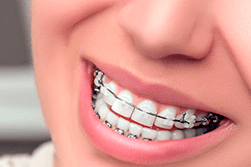.


Your child’s beautiful but ultimately not straight smile has been wonderful to look at over these past 10 to 15 years. But now that he or she is a bit older, it’s time to start thinking about how to straighten out those teeth so that you can give your child a happier and fulfilling future. There’s a lot to gain from getting braces. And although your child may not understand it now, she or he will thank you for it later if you just make braces a requirement now. And with recent advances in oral technology, your child will have many more options than the ones you had as a kid. So in the interest of providing your child with a better adolescent experience than the one you had, here are the pros and cons to each of the options that he or she will have available, brought to you by the orthodontist Allendale.
The Standard Traditional Metal Braces: These are the standard design that have been used for decades and they’re still fairly common, largely due to the fact that they actually work really well, even if they are a bit of a pain at times. One difference in the braces that are used today versus the ones from years past is that the actual metal part is much smaller on each tooth, so they pose much less of a burden, regarding matters of discomfort and the degree to which it creates a distraction when the person smiles. There are two main pros to this style. The first and most important one, is that they’re the most affordable. Secondly, if you time it right, your child may want to express him or herself with colorful rubber bands. The con, of course, is the fact at the end of the day, they’re still the most noticeable means of straightening your teeth and that can be embarrassing for a child.
Ceramic Braces: These are practically the same as the metal option, only they’re camouflaged a bit more effectively. They’re designed to blend in with your teeth by being adjusted to be either clear or to the particular hue of the person’s teeth. There’s also the option of getting wires that are tooth colored to really minimize the visibility. The pro of course is that they’re less visible. They can really do the trick if the person is careful not to eat or drink anything that could change the color. The con, however, is that at the end of the day, when it’s all said and done, they still are visible and at times they can just make the person look like he or she has dirty teeth because the braces stain easily. From a distance, it’s not obvious enough to see that there are braces, so if your child isn’t irresponsible with consumption, drinking lots of Coca-Cola, etc., they may regret their decision a few months later. And finally, Ceramic braces are also a bit more expensive than the metal.
Invisalign: If you haven’t heard of this then you definitely want to read up on it. This is the least invasive means of straightening one’s teeth. Patients can eat and drink pretty much whatever they want without doing damage. They’re completely invisible and they eliminate both the physical discomfort and embarrassment that come with their metal counterparts. However, they can’t be used with children, only teens and adults. Also, they are much less effective than metal braces. So if the case is severe, then your child won’t have the option until other measures are taken first, namely, metal, ceramic, or lingual braces beforehand.
Learn more about your child’s options by calling Pediatric Dental Associates at 201-652-7020. We’re available and eager to help. Call now for an orthodontist Allendale residents can rely on.